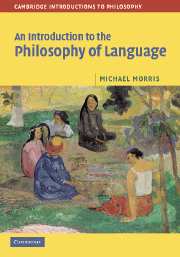Book contents
- Frontmatter
- Contents
- Acknowledgements
- Introduction
- 1 Locke and the nature of language
- 2 Frege on Sense and reference
- 3 Russell on definite descriptions
- 4 Kripke on proper names
- 5 Natural-kind terms
- 6 Quine on de re and de dicto modality
- 7 Reference and propositional attitudes
- 8 The semantics of propositional attitudes
- 9 Davidson on truth and meaning
- 10 Quine and Davidson on translation and interpretation
- 11 Quine on the indeterminacy of translation
- 12 Austin on speech acts
- 13 Grice on meaning
- 14 Kripke on the rule-following paradox
- 15 Wittgenstein on the Augustinian picture
- Glossary
- Works cited
- Index
10 - Quine and Davidson on translation and interpretation
Published online by Cambridge University Press: 05 June 2012
- Frontmatter
- Contents
- Acknowledgements
- Introduction
- 1 Locke and the nature of language
- 2 Frege on Sense and reference
- 3 Russell on definite descriptions
- 4 Kripke on proper names
- 5 Natural-kind terms
- 6 Quine on de re and de dicto modality
- 7 Reference and propositional attitudes
- 8 The semantics of propositional attitudes
- 9 Davidson on truth and meaning
- 10 Quine and Davidson on translation and interpretation
- 11 Quine on the indeterminacy of translation
- 12 Austin on speech acts
- 13 Grice on meaning
- 14 Kripke on the rule-following paradox
- 15 Wittgenstein on the Augustinian picture
- Glossary
- Works cited
- Index
Summary
Key texts
W. V. O. Quine, Word and Object (Cambridge, MA: MIT Press, 1960), ch. 2; Donald Davidson, ‘Radical Interpretation’, in his Inquiries into Truth and Interpretation (Oxford: Oxford University Press, 1984), pp. 125–40.
Introduction
So far we've been concerned with the kind of meaning different kinds of linguistic expression have, and with the way in which the meaning of sentences depends on the meaning of their parts. But there might seem to be more basic issues in the philosophy of language. Don't we need to understand the role of language in people's lives?
This issue will occupy us, in various forms, over the next few chapters. In this chapter we'll be examining the conception of language and meaning proposed by Willard Van Orman Quine and developed by Donald Davidson. They're concerned to show what kind of phenomena languages are, and what it is to make sense of them. Since the meaning of words is what there is to make sense of in them, an account of making sense of language is bound to be illuminating about meaning. Indeed, Davidson uses it to try to supply what we found to be missing from his semantic proposal, considered on its own.
The general picture of language developed by Quine and Davidson has been hugely influential. There are some differences between them on questions of detail, as will be clear shortly; and people have differed from both of them on other points.
- Type
- Chapter
- Information
- An Introduction to the Philosophy of Language , pp. 194 - 213Publisher: Cambridge University PressPrint publication year: 2006



